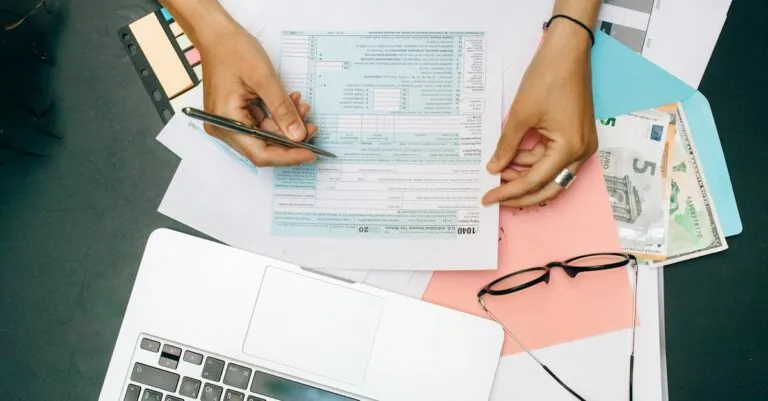In a world where smartphones do everything from ordering pizza to tracking your cat’s daily adventures, why not let your iPhone take a stab at monitoring your blood pressure? Gone are the days of awkward cuff fittings and waiting rooms filled with outdated magazines. With just a few taps, you can turn your phone into a handy health assistant.
Table of Contents
ToggleOverview of Blood Pressure Monitoring
Blood pressure monitoring offers crucial insights into cardiovascular health. Devices used for this purpose traditionally require cuffs that inflate and deflate, which can be cumbersome. Modern technology, however, allows users to measure blood pressure conveniently using an iPhone.
Many iPhone apps integrate with external sensors or use the phone’s features to deliver accurate readings. Users can quickly check their blood pressure with just a few taps on their devices. Regular monitoring aids in identifying trends in blood pressure levels, promoting proactive health management.
Various factors influence blood pressure readings. Stress, diet, and physical activity all play significant roles in fluctuations. Tracking these readings over time helps healthcare professionals make informed decisions regarding treatment and lifestyle changes.
Integrating blood pressure monitoring into daily routines enhances awareness of cardiovascular health. Users can set reminders to check their blood pressure periodically. With the ability to store and review data, users gain valuable insights into their health trends.
The accuracy of iPhone-based blood pressure measurements depends on the technology used. Some apps work with smart devices like Bluetooth-enabled blood pressure monitors, while others provide estimations through touch or sensors. Users should choose a reliable app or device to ensure precision in their readings.
Implementing iPhone-based blood pressure monitoring simplifies health tracking. Individuals can share their data with healthcare providers effortlessly. Maintaining a consistent record of blood pressure levels fosters engagement in one’s health and well-being.
Using iPhone for Blood Pressure Checking
Checking blood pressure with an iPhone streamlines the process through innovative apps and accessories.
Required Apps and Accessories
Users must download apps specifically designed for blood pressure monitoring. Popular options include Heart Rate Monitor and Blood Pressure Companion. These applications often require Bluetooth-enabled accessories for accurate readings. Many users opt for devices such as smart blood pressure cuffs that connect wirelessly. These cuffs synchronize data seamlessly with the apps, ensuring real-time monitoring. Availability of these devices tends to be broad, making them accessible for most users.
Step-by-Step Guide
To check blood pressure, begin by pairing the compatible blood pressure cuff with the iPhone. Open the chosen app next and follow its instructions for setup. Users should sit comfortably and remain still during measurement for the most accurate readings. Activate the cuff after positioning it on the upper arm or wrist as directed. The app typically displays the results. Finally, users can save the readings for future reference, allowing for easy tracking of changes over time. Regular use builds awareness of individual health trends and promotes proactive health management.
Accuracy of iPhone Blood Pressure Readings
Monitoring blood pressure with an iPhone offers convenience, but accuracy can vary. Measurements taken through apps may not always match those from traditional devices. Many iPhone apps depend on external Bluetooth-enabled cuffs for precise readings. Comparatively, standard methods often involve using a sphygmomanometer, providing direct and reliable measurements.
Comparison with Traditional Methods
Traditional blood pressure monitors deliver direct pressure readings using inflatable cuffs and stethoscopes. With high accuracy, they remain the gold standard in clinical settings. In contrast, iPhone-based methods can rely on external sensors that sync with apps for readings. Variability exists among different apps; some provide accurate estimates based on heart rate data and algorithmic analysis.
Smartphone applications simplify the process, allowing users rapid and convenient tracking. Despite this, professionals often recommend verifying readings through traditional measures, especially for individuals with health concerns. Users need to understand these differences to effectively manage their cardiovascular health.
Tips for Effective Monitoring
Regular checks ensure accurate monitoring. Users should maintain a consistent schedule for measuring blood pressure, ideally at the same time each day. Proper positioning of the body impacts readings; sitting comfortably with feet flat on the ground is recommended.
Stay still and avoid talking during measurements. Movement can introduce inaccuracies, leading to false readings. Furthermore, it helps to place the cuff correctly on the upper arm. The bottom edge of the cuff should sit about one inch above the elbow crease.
Prioritize using compatible apps and devices. When choosing an app, ensure it integrates well with specific Bluetooth-enabled cuffs, especially those recommended by healthcare professionals. Accurate data collection relies on a reliable connection between the app and the device.
Review history regularly. Most apps store previous readings, providing insights into trends and fluctuations. Observing patterns can empower users to make informed health decisions.
Consider external factors that influence blood pressure. Stress, physical activity, and dietary choices affect measurements. Note these variables during readings; keeping a journal may help track such influences.
Consult with healthcare providers periodically. Sharing data from the app can facilitate important discussions about cardiovascular health. Engaging a doctor in conversations about the readings fosters proactive health management.
Staying informed about advancements in blood pressure monitoring technology can enhance accuracy and ease. New features and updates might be available through app developers, ensuring the most effective monitoring practices.
Monitoring blood pressure through an iPhone offers a modern and convenient approach to managing cardiovascular health. With the right apps and compatible devices users can track their readings easily and integrate this practice into their daily lives. Regular monitoring not only helps identify trends but also encourages proactive health management.
While iPhone-based measurements provide accessibility and ease of use it’s essential to remain aware of their limitations. Users should verify readings with traditional methods when necessary and consult healthcare professionals for personalized advice. Embracing technology for health monitoring can lead to better engagement and informed decisions about one’s well-being.




